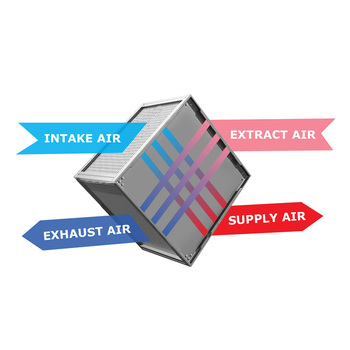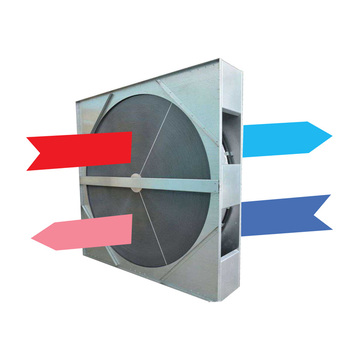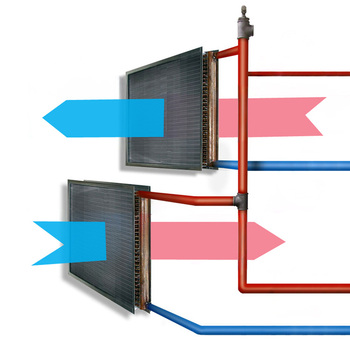What are the most common types of heat recuperators in AHU and how do they work?
The three most common types of energy recovery heat exchangers (recuperators) in air handling units (AHUs) are:
• Plate heat exchangers
• Rotary heat exchangers
• Liquid-coupled heat exchangers
• Rotary heat exchangers
• Liquid-coupled heat exchangers
Each type has distinct designs and use cases based on efficiency and specific advantages.
Plate recuperators
Plate exchangers, as their name suggests, use a package of plates to transfer heat between two air flows. The most common type is the cross-flow exchanger, where air passes through perpendicular channels in the plates. When the outgoing warm air passes through one set of plates and the incoming cool air through another, heat is effectively transferred from the warm air to the cool air, reducing the load on the heating and cooling systems.
Another vital part of the plate heat exchanger is a bypass with an actuator controlled damper. Usually fit in the supply air stream, it is used to direct outdoor air (partially or completely) without passing through the recuperator.
Another vital part of the plate heat exchanger is a bypass with an actuator controlled damper. Usually fit in the supply air stream, it is used to direct outdoor air (partially or completely) without passing through the recuperator.
 Plate exchanger
Plate exchangerRotary recuperators
Rotary heat exchangers, or heat wheels, offer efficient heat recovery by rotating a heat-absorbing wheel between the supply and exhaust air streams. They are capable of transferring both sensible and latent heat. Sensible heat refers to temperature-related energy, while latent heat relates to moisture content.
Rotary exchangers come in three types:
• Condensation type: Recovers moisture only in cold seasons.
• Enthalpy type: Recovers moisture in both cold and transitional seasons.
• Sorption type: Recovers moisture year-round.
• Enthalpy type: Recovers moisture in both cold and transitional seasons.
• Sorption type: Recovers moisture year-round.
Condensation heat wheels are the most commonly used types of exchangers. They are cheaper than the others and do not require additional equipment for proper operation.
 Rotary recuperator
Rotary recuperatorLiquid-coupled recuperators
A liquid-coupled heat recovery system consists of two separate tube fin coils, one located in the supply air stream and the other in the exhaust. These coils are connected by a liquid circuit, usually filled with a glycol-water mixture that transfers heat from the exhaust air to the supply air.
These systems are highly effective in recovering heat from high-temperature exhaust air, making them well-suited for industrial settings. They can also be installed at a distance between supply and exhaust sections, offering more flexibility in terms of space planning.
These systems are highly effective in recovering heat from high-temperature exhaust air, making them well-suited for industrial settings. They can also be installed at a distance between supply and exhaust sections, offering more flexibility in terms of space planning.
 Liquid-coupled recuperator
Liquid-coupled recuperatorEfficiency of heat recovery systems
The efficiency of heat recovery exchangers varies based on the type and the specific operating conditions. Below are typical temperature efficiency ranges:
• Plate heat exchangers: 40-80%
• Rotary heat exchangers: 60-85%
• Liquid-coupled heat exchangers: 40-65%
• Rotary heat exchangers: 60-85%
• Liquid-coupled heat exchangers: 40-65%
The efficiency depends on many factors such as temperature difference (ΔT) between air streams, surface area of the exchanger, airflow rates, and environmental conditions.
Air leakages in heat recovery systems
Air leakage can reduce the performance of a heat recovery system by allowing exhaust air to mix with supply air, potentially introducing contaminants. Here is a summary of leakage rates for the different types of heat exchangers:
• Plate heat exchangers: Minimal air leakage, typically less than 1%, and it can be further reduced with better sealing and installation practices.
• Rotary heat exchangers: More prone to leakage, though it can be minimized with a purge section and correct fan placement, reducing leakage to less than 0.1%.
• Liquid-coupled heat exchangers: No air leakage occurs because the supply and exhaust airflows are completely isolated from one another.
• Plate heat exchangers: Minimal air leakage, typically less than 1%, and it can be further reduced with better sealing and installation practices.
• Rotary heat exchangers: More prone to leakage, though it can be minimized with a purge section and correct fan placement, reducing leakage to less than 0.1%.
• Liquid-coupled heat exchangers: No air leakage occurs because the supply and exhaust airflows are completely isolated from one another.
Controlling heat recuperators
Effective control of heat recuperators ensures optimal performance, protection from freezing, and reduced energy consumption. Here are some typical control strategies:
• Plate heat exchangers: The bypass damper can be controlled based on exhaust temperature and humidity levels to prevent frost accumulation.
• Rotary heat exchangers: The speed of the wheel is controlled by a frequency inverter. It operates at lower speeds in freezing conditions and can be stopped or slowed during certain conditions to avoid pressure drops.
• Liquid-coupled heat exchangers: These systems require pump, valve, and sensors to manage the flow of the heat transfer liquid. The position of the control valve is adjusted based on the air temperature or energy recovery needs.
• Rotary heat exchangers: The speed of the wheel is controlled by a frequency inverter. It operates at lower speeds in freezing conditions and can be stopped or slowed during certain conditions to avoid pressure drops.
• Liquid-coupled heat exchangers: These systems require pump, valve, and sensors to manage the flow of the heat transfer liquid. The position of the control valve is adjusted based on the air temperature or energy recovery needs.
What is the best type of a heat exchanger for your application?
The choice of a heat exchanger largely depends on the specific needs of your application:
• Plate heat exchangers are ideal for simple installations with minimal leakage concerns.
• Rotary heat exchangers provide excellent heat and moisture recovery, but require more careful control to minimize air leakage.
• Liquid-coupled heat exchangers are perfect for high-temperature industrial applications or installations where supply and exhaust sections must be separated.
• Rotary heat exchangers provide excellent heat and moisture recovery, but require more careful control to minimize air leakage.
• Liquid-coupled heat exchangers are perfect for high-temperature industrial applications or installations where supply and exhaust sections must be separated.
Check our solutions section to choose a control system for AHU with a heat recuperator.
